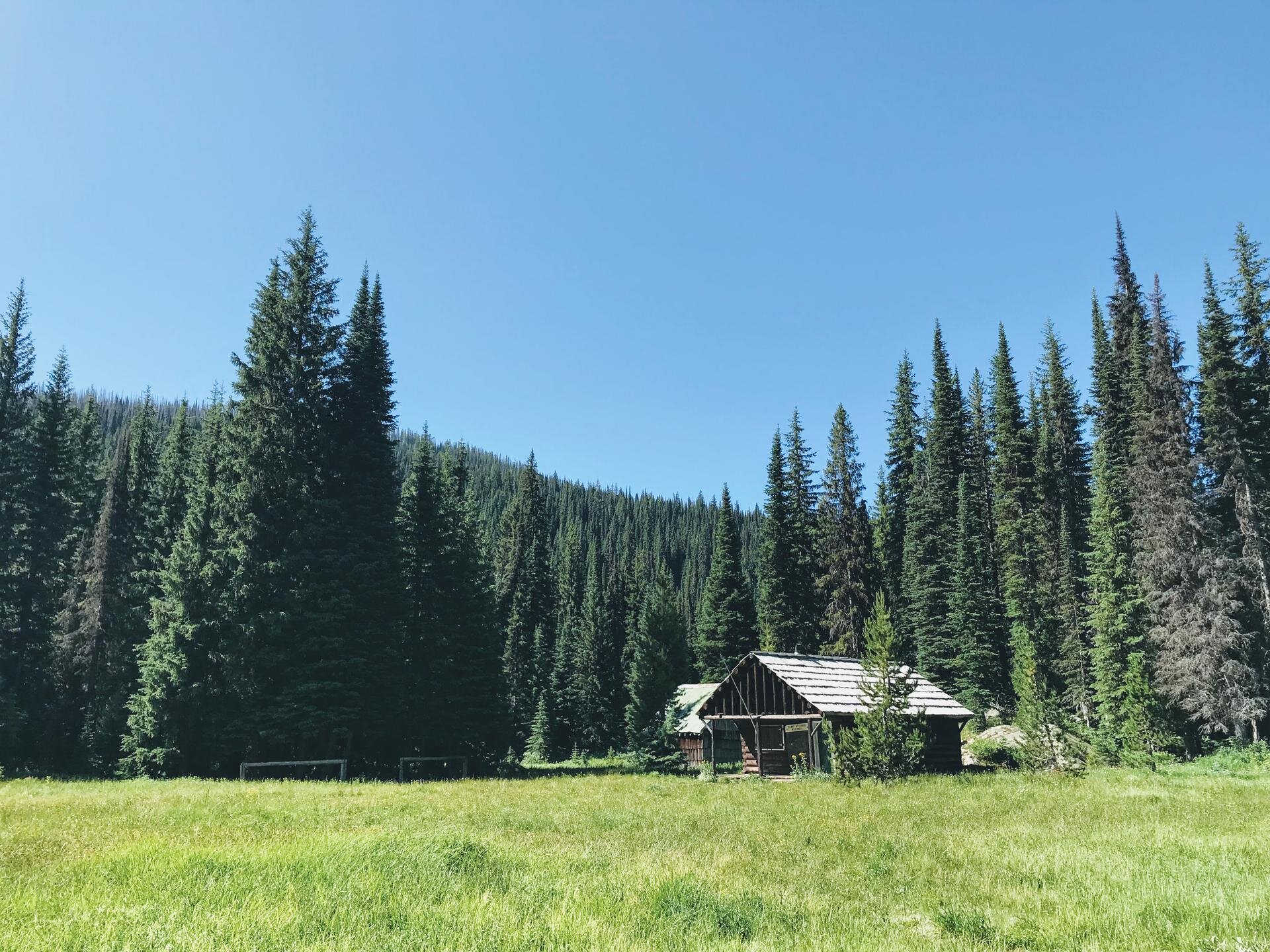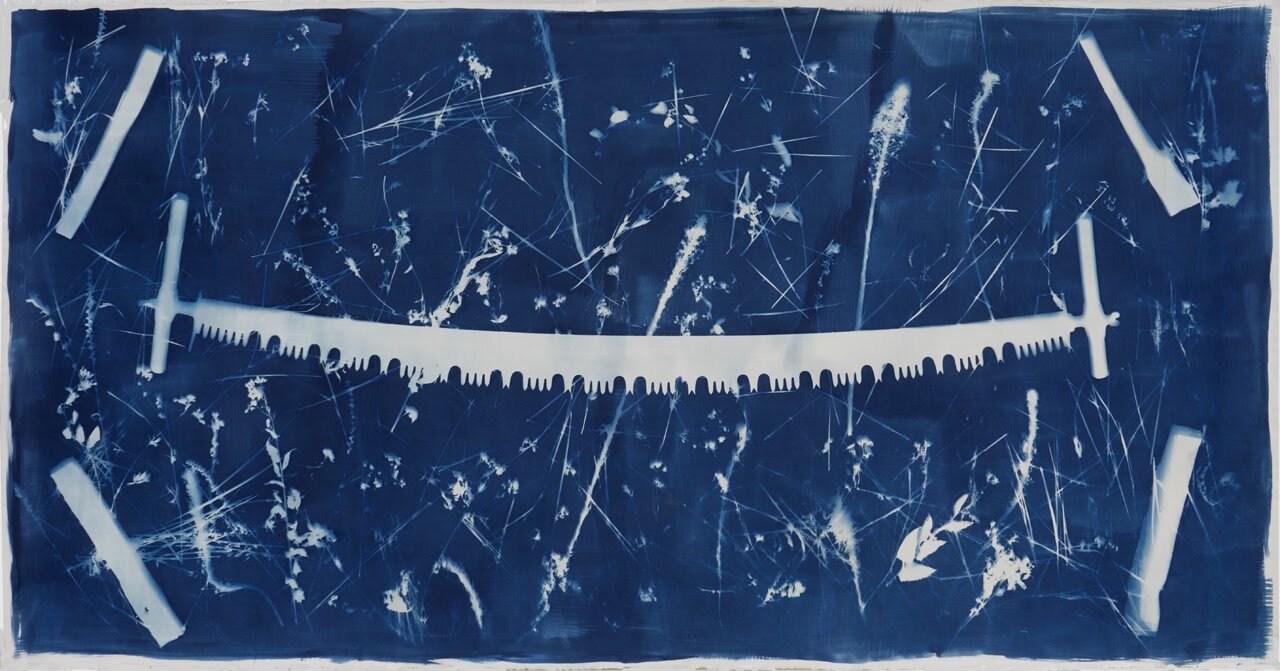A Conversation with Jonathan Marquis
2019 Open AIR Artist-In-Residence in partnership with the Selway-Bitterroot Frank Church Foundation
"I think of art-making as a portal to the ecological interconnectedness of people and place – it is a way of collaborating with the land to create stories."
- Jonathan Marquis
Above: The Gatherer, 30” x 22”, Cyanotype on paper. Open AIR permanent collection.
Open AIR: Can you talk about your experience as an Artist-in-Residence?
Marquis: On a warm July morning, I hopped into a small fixed-wing airplane outside Missoula and 40 mins later the plane flew away over some mountains and I was left standing in a large grassy field in the middle of nowhere. Well, nowhere is always somewhere, and I was at the Fish lake grass airstrip and guard station in a remote region of the Selway-Bitterroot Wilderness.
The next day my art residency partner Erin DiGiovanni and her two dogs arrived at the cabin from the nearest trailhead, some 16 miles away by foot. We then set into a
regular routine of making art, hiking, and cooking – sometimes with food foraged
from just beyond the cabin door.
The overall experience was profound and quiet. Lots of time to walk and think. Two
times a day we had to check- in by radio with the US Forest Service Grangeville dispatch. As cabin volunteers, we worked around the cabin and monitored all the flights that landed at Fish Lake. A few backcountry aviators, one hiker, and the local trail crew were about all the contact we had with the outside world. I liked it so much I plan to return again this summer.
Above: The Forest Service cabin at Fish Lake Airstrip. Photo Credit: Jonathan Marquis.
Open AIR: What was your research process during this time?
Marquis: As soon as I got off the plane and unloaded the gear into the cabin, I immediately began walking and photographing to get to know the place. I explored all the nearby structures – the cabin, barn, and outhouse, I found all the nearby trails and began studying the flora. I wrote and read almost every day, made a couple of graphite rubbings of the wood map mounted to the exterior of the cabin, and explored the tools and nearby wildflowers with cyanotypes.
There were two crosscut saws hanging on the cabin wall, one for a single operator and another meant for two, each was about as tall as me. I was drawn to them because their design and size so eloquently corresponded to the intended task and the scale of the wilderness.
The two-handled, six-foot lance-tooth crosscut saw is a revelation of the camaraderie of wilderness work. Look closely and you can hear the saw at work in the rhythmic pattern of the teeth. The wildflowers on the other hand are so gentle, so delicate, so vibrant with color, they are each like little eruptions of laughter and delight. The poetics of wilderness work are revealed in the saw’s poignant design and the delicacy of the flowers. I titled the cyanotype “The Forester” after Bruegel’s “The Harvesters” because of the way the tree in the sixteenth-century painting gathers the composition, the people, and their activities into a mutually generative expression of culture and nature.
Above: The Forester, cyanotype on paper, 2019, 51” x 96”
Open AIR: What keeps you returning to this body of work?
Jonathan: I keep returning to the subject of glaciers and wilderness because I am struck by the sensory experiences one encounters when walking in Montana’s wildland areas. I am interested in the lives that make their home in these places, and how they overlap with our own lives. I think of art-making as a portal to the ecological interconnectedness of people and place – it is a way of collaborating with the land to create stories.
Open AIR: What are you up to now post-residency?
Jonathan: I’ve been fundraising for my projects by selling botanical cyanotypes at art markets. However, with many markets cancelled or postponed as a result of Covid-19, I took the opportunity to open up an online store on my website.
I’ve also been working on a project called Downwaste. It’s a series of cyanotypes made at and with the melting-edge of glaciers in Glacier National Park. Downwaste grew out of a question, do glacier draw? The cyanotype surface is receptive to light and material encounters that enables a glacier to draw itself. This summer, I hope to return to glaciers in Montana and continue this project. These works are supposed to go on display at FrontierSpace in June, however, with everything going on we’ll see if that happens.
This interview was conducted remotely. Thank you Jonathan for sharing your experience with us. Learn more about his work at http://www.jonathanmarquis.com/.
This Open AIR Artist-in-Residency was made possible by a collaboration with The Selway Bitterroot Frank Church Foundation, a community of wilderness-minded and hardworking individuals, dedicated to connecting wilderness with the people who work, live, and play within it. The efforts of the SBFC community protect and preserve the natural, pristine character of wilderness.







